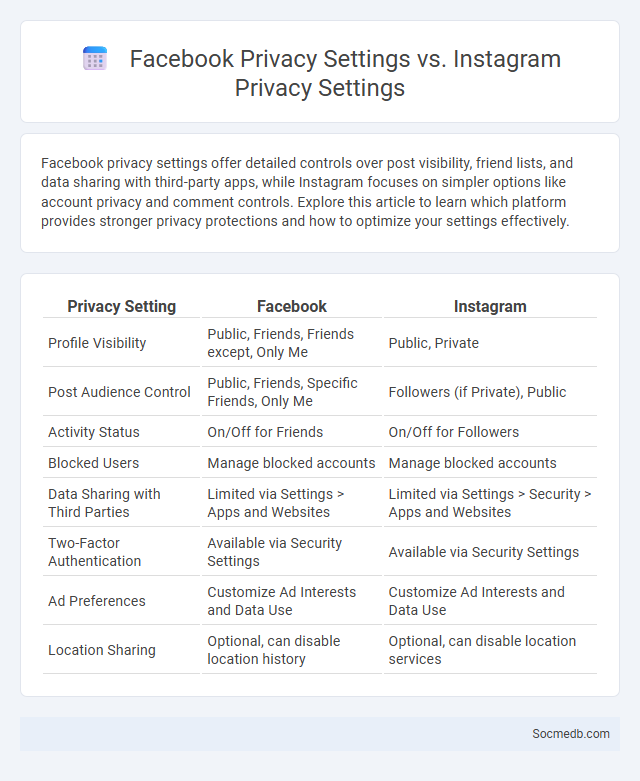
Photo illustration: Facebook Privacy Settings vs Instagram Privacy Settings
Facebook privacy settings offer detailed controls over post visibility, friend lists, and data sharing with third-party apps, while Instagram focuses on simpler options like account privacy and comment controls. Explore this article to learn which platform provides stronger privacy protections and how to optimize your settings effectively.
Table of Comparison
| Privacy Setting | ||
|---|---|---|
| Profile Visibility | Public, Friends, Friends except, Only Me | Public, Private |
| Post Audience Control | Public, Friends, Specific Friends, Only Me | Followers (if Private), Public |
| Activity Status | On/Off for Friends | On/Off for Followers |
| Blocked Users | Manage blocked accounts | Manage blocked accounts |
| Data Sharing with Third Parties | Limited via Settings > Apps and Websites | Limited via Settings > Security > Apps and Websites |
| Two-Factor Authentication | Available via Security Settings | Available via Security Settings |
| Ad Preferences | Customize Ad Interests and Data Use | Customize Ad Interests and Data Use |
| Location Sharing | Optional, can disable location history | Optional, can disable location services |
Overview of Facebook and Instagram Privacy Settings
Facebook and Instagram offer comprehensive privacy settings that allow users to control who can see their posts, send messages, or interact with their profiles. Both platforms provide options for managing data sharing, ad preferences, and activity visibility through customizable controls in the privacy dashboard. Users can enhance account security by enabling two-factor authentication and reviewing login alerts, ensuring better protection of personal information.
Key Differences in Privacy Controls
Social media platforms vary significantly in their privacy controls, with Facebook offering granular options for audience selection on posts and detailed settings for third-party app access. Twitter emphasizes user control over who can see tweets and send messages, while Instagram provides settings for private profiles and restrictions on comments and interactions. These differences highlight the importance of understanding platform-specific features to effectively manage personal data and online visibility.
Personal Data Sharing: Facebook vs Instagram
Facebook collects extensive personal data through user interactions, posts, and third-party apps, enabling highly targeted advertising and personalized content. Instagram, owned by Facebook, also gathers significant user data but emphasizes visual content engagement, tracking likes, follows, and story views to refine user profiling. Understanding how both platforms share your personal data helps you manage privacy settings and control targeted advertising exposure effectively.
Managing Audience and Post Visibility
Effective management of audience targeting on social media platforms enhances post visibility by aligning content with user interests and behaviors. Utilizing analytics tools to analyze demographic data and engagement patterns allows for precise segmentation and optimized scheduling of posts. Leveraging algorithm-friendly content formats, such as interactive stories or video, increases reach and fosters higher audience interaction rates.
Profile Customization and Discoverability
Profile customization enhances social media presence by allowing users to create unique, branded profiles featuring personalized bios, profile pictures, and cover images that resonate with target audiences. Effective use of keywords and hashtags within profiles improves discoverability, making it easier for potential followers and clients to find users through search engines and platform algorithms. Consistent updating of profile elements aligned with trending topics increases visibility and engagement across social networks.
Third-Party App Permissions and Integration
Managing third-party app permissions is crucial for securing your social media accounts and personal data. Regularly review and update which external applications have access to your social media profiles to prevent unauthorized data sharing and potential security breaches. Ensuring proper integration settings helps maintain control over your digital footprint and protects your online privacy.
Digital Footprint: Definition and Implications
A digital footprint refers to the trail of data users leave behind when interacting on social media platforms, including posts, comments, and shared content. This footprint impacts personal privacy, online reputation, and can influence employment opportunities as employers often review candidates' online presence. Understanding the permanence and visibility of digital footprints is essential for managing digital identity and mitigating potential negative consequences.
Impact of Social Media Privacy on Digital Footprint
Social media privacy settings directly influence your digital footprint by controlling which personal information is accessible to others and how it is used by platforms and third parties. Limited privacy controls can lead to unintended data exposure, affecting your online reputation and potential opportunities. Protecting your social media privacy helps manage the information trail you leave, reducing risks of data misuse and enhancing your digital security.
Best Practices for Enhancing Online Privacy
To enhance online privacy on social media platforms, users should regularly update privacy settings to restrict profile visibility and limit data sharing with third-party applications. Employing strong, unique passwords combined with two-factor authentication reduces the risk of unauthorized account access. Avoiding oversharing personal information and reviewing app permissions frequently helps maintain better control over digital footprints and sensitive data exposure.
Conclusion: Safeguarding Your Digital Presence
Protecting your digital presence requires vigilant monitoring of account activity and strong, unique passwords across all social media platforms. Enabling two-factor authentication and regularly reviewing privacy settings significantly reduces the risk of unauthorized access and data breaches. Staying informed about evolving cybersecurity threats empowers you to maintain control over your online identity and personal information.
 socmedb.com
socmedb.com